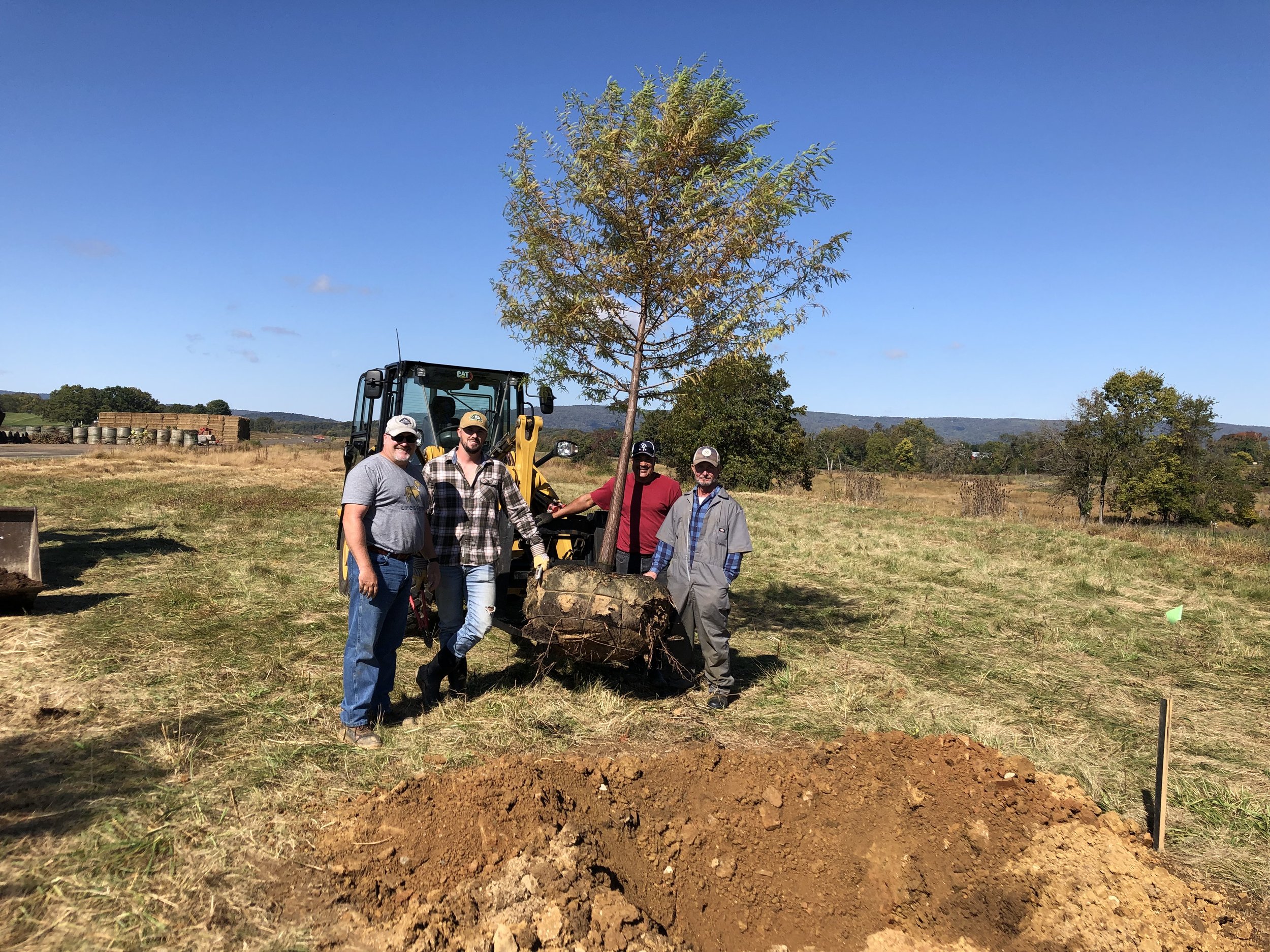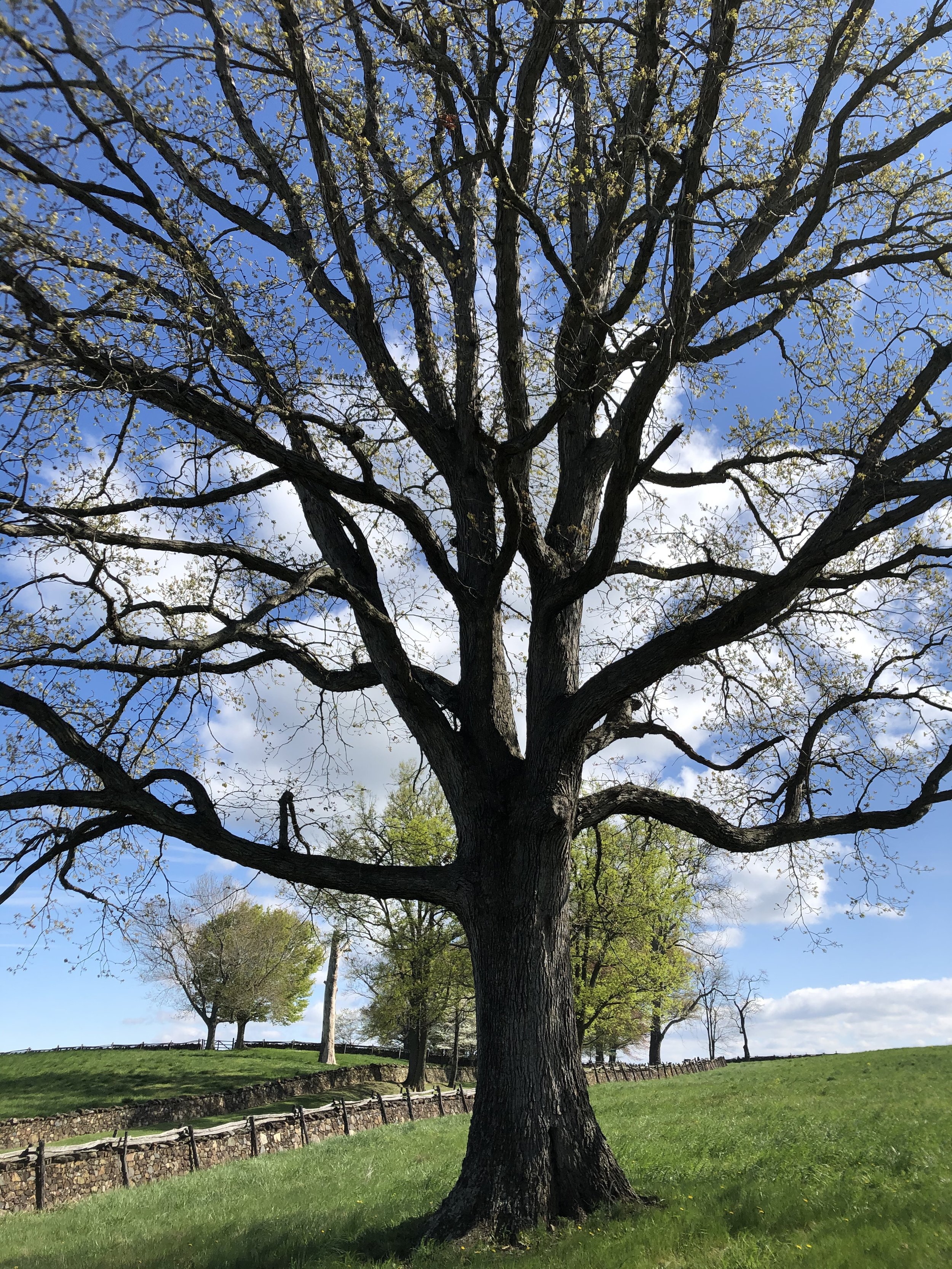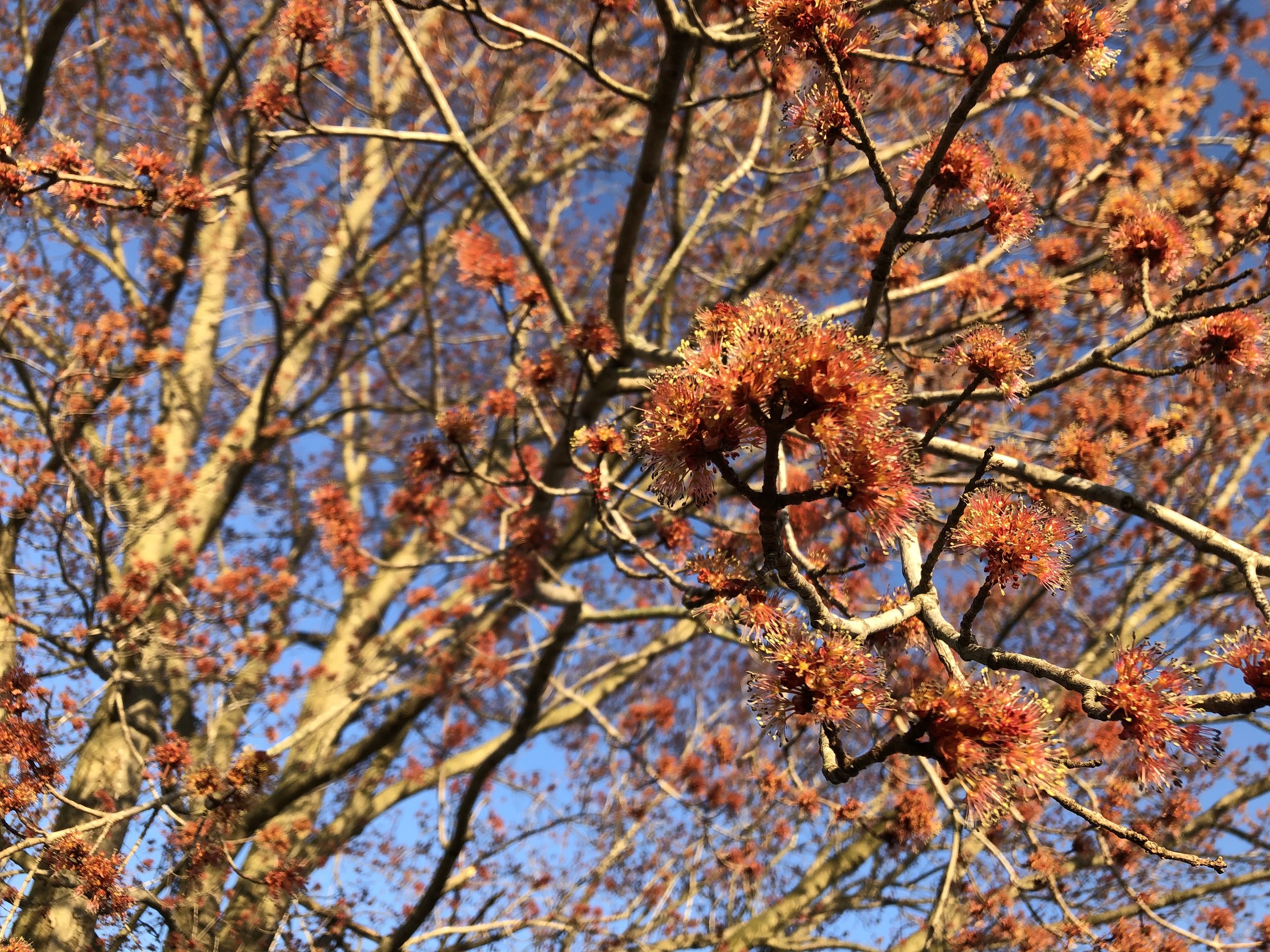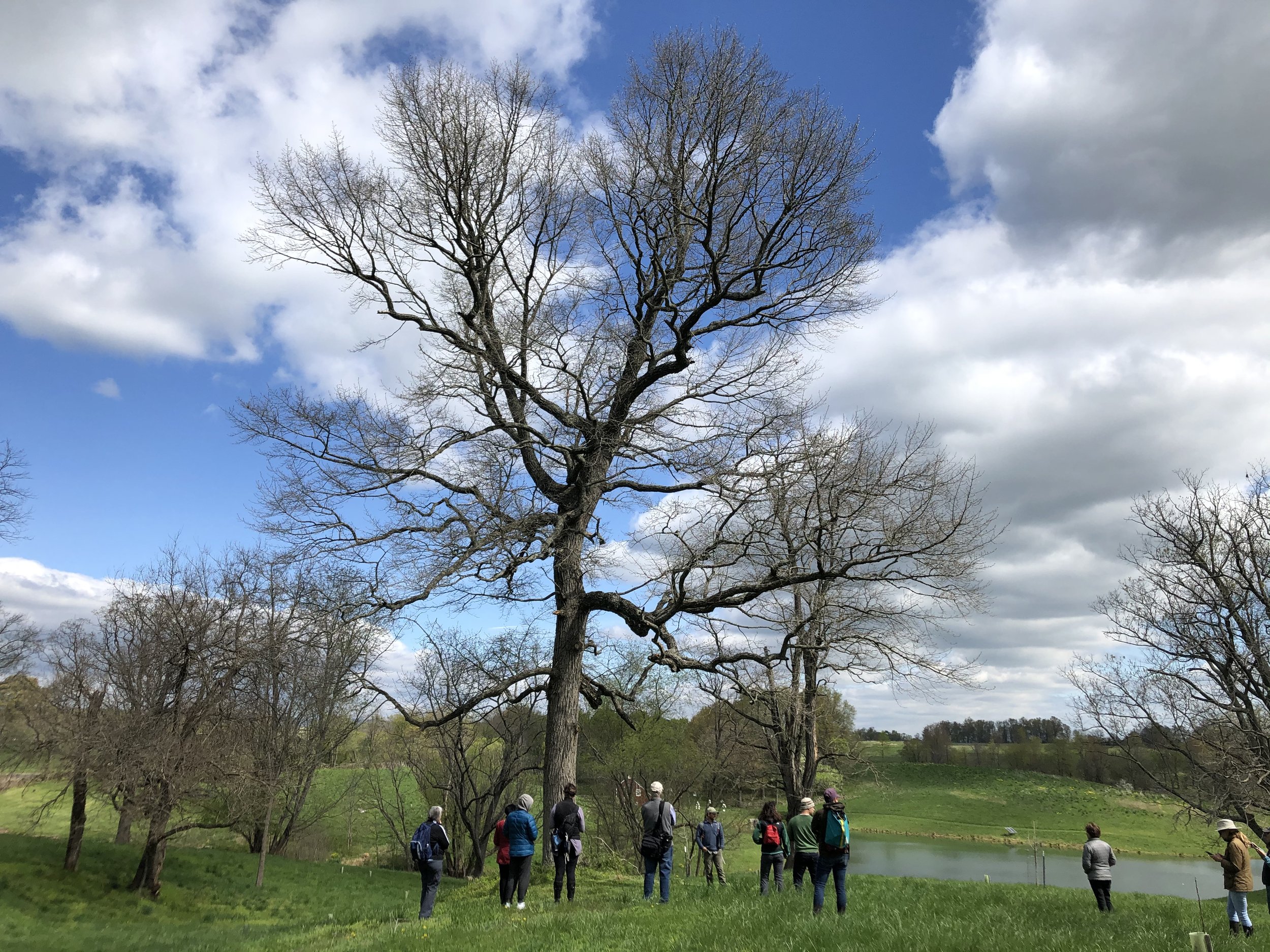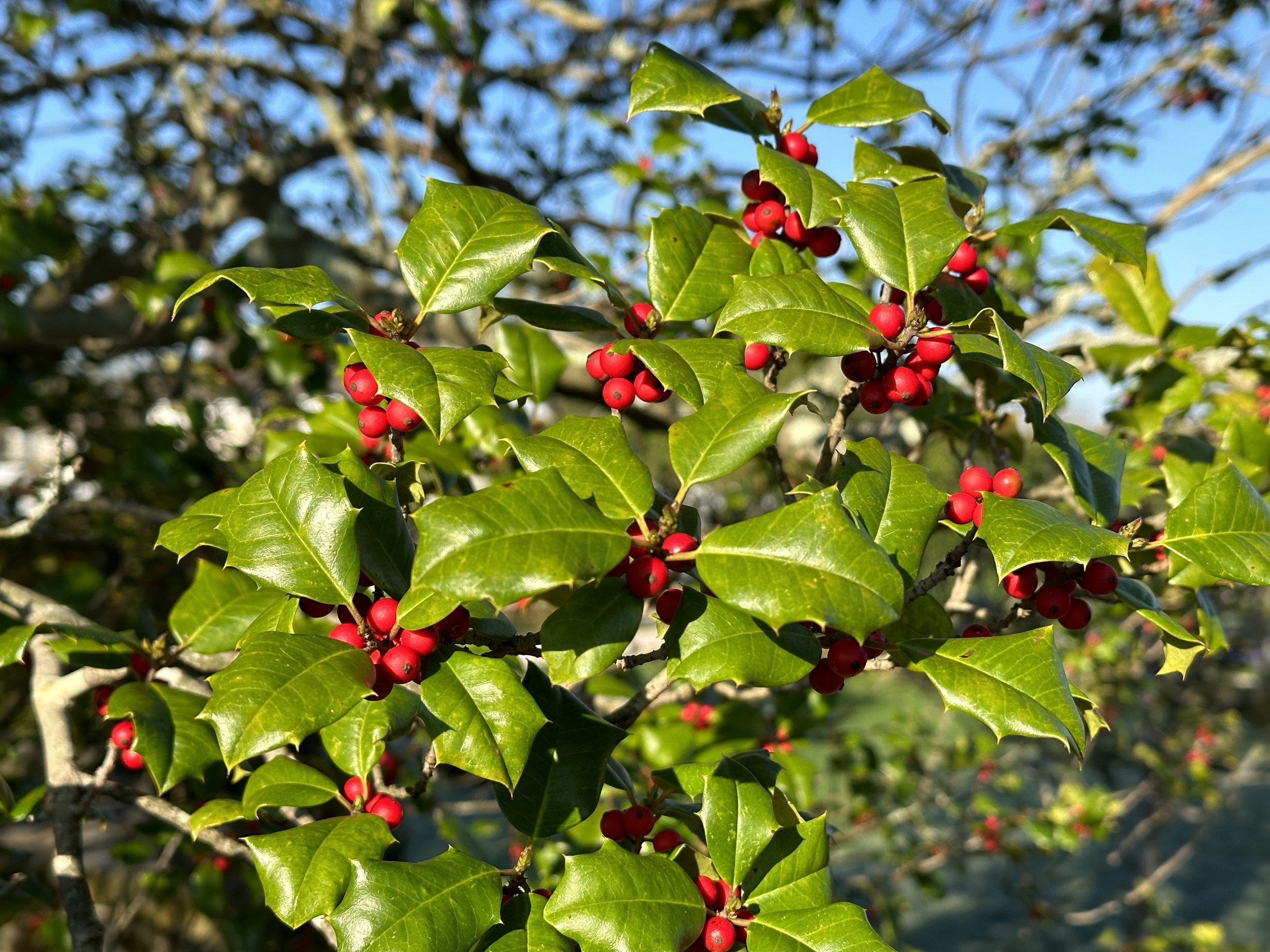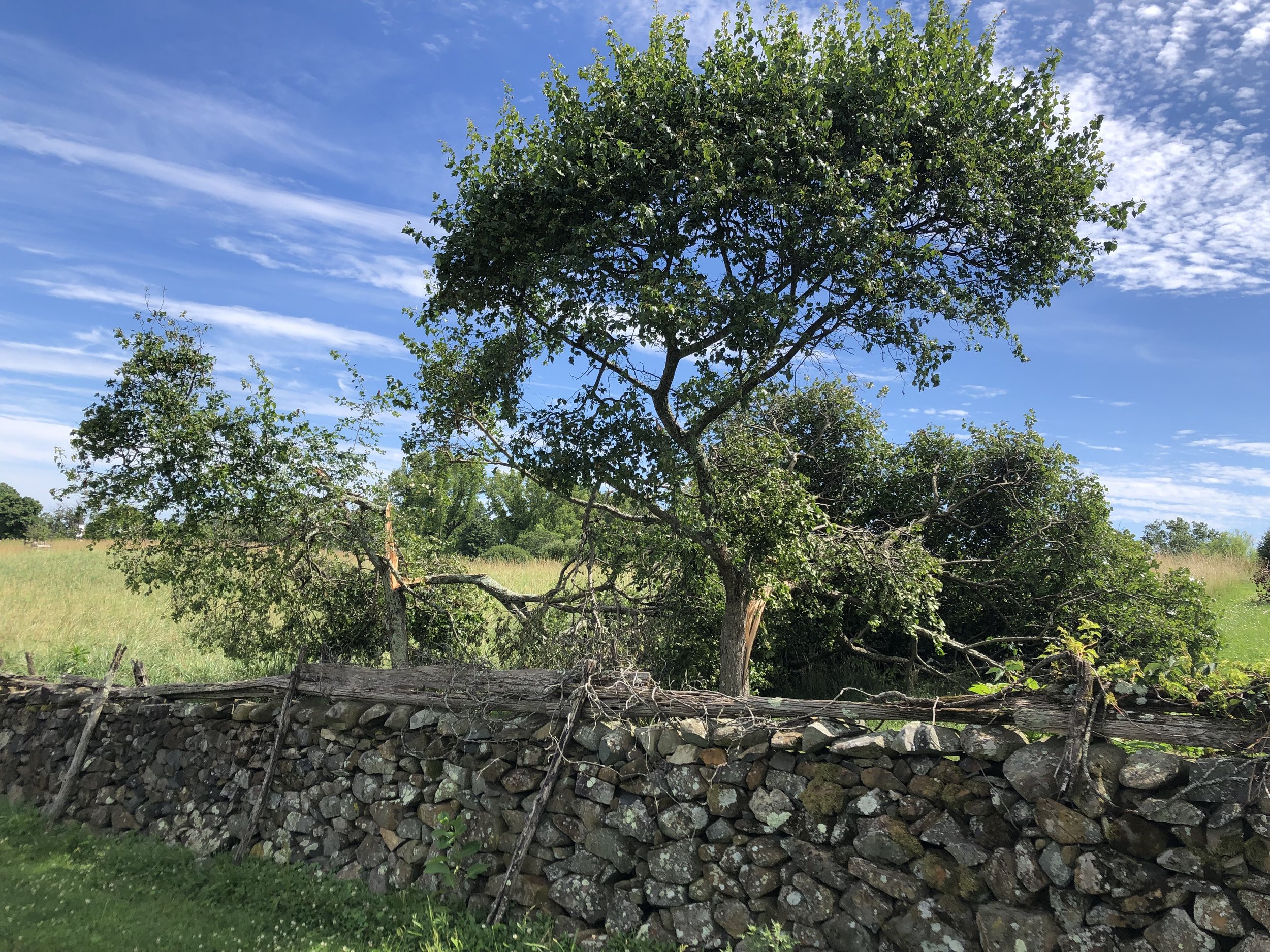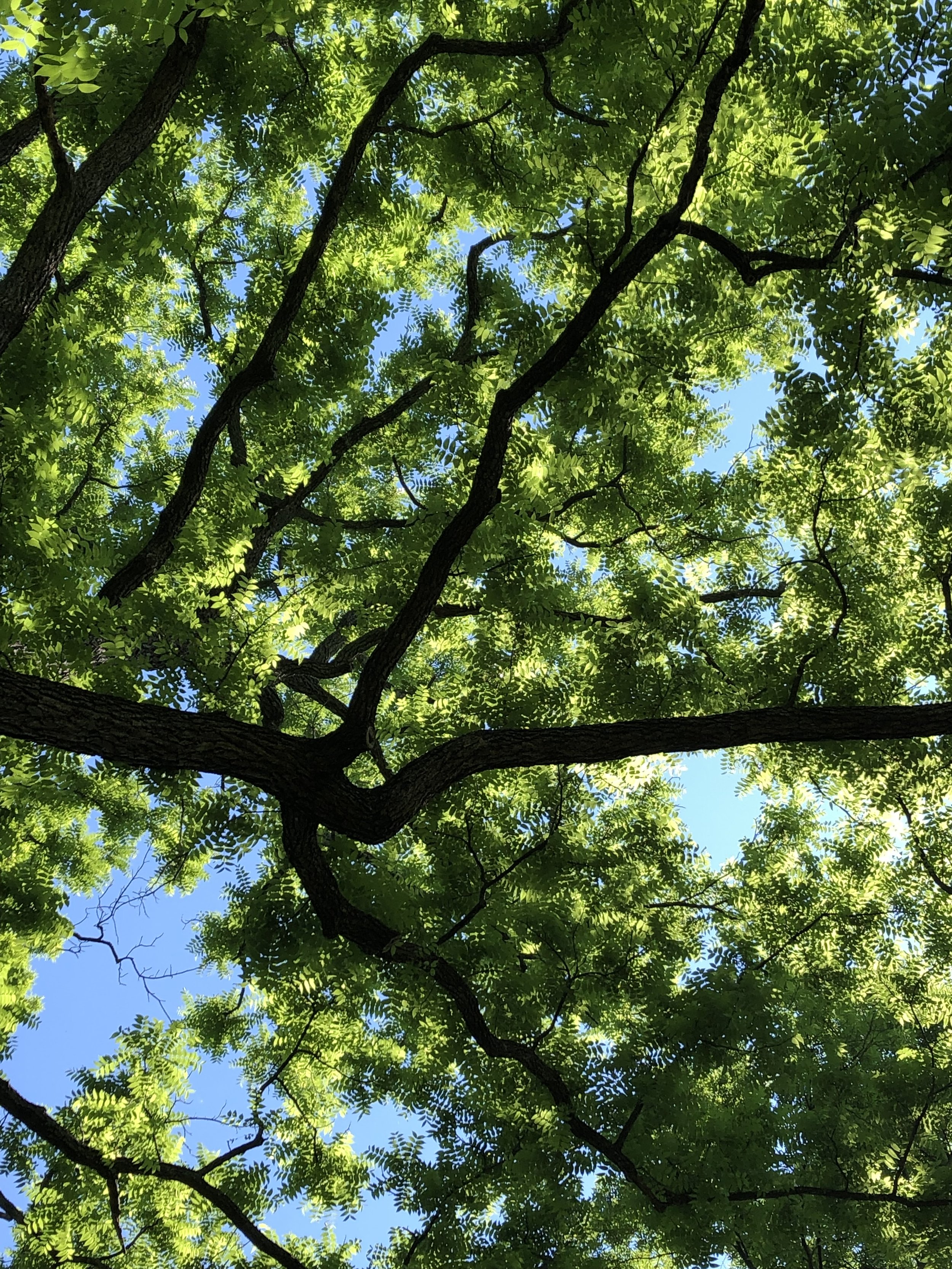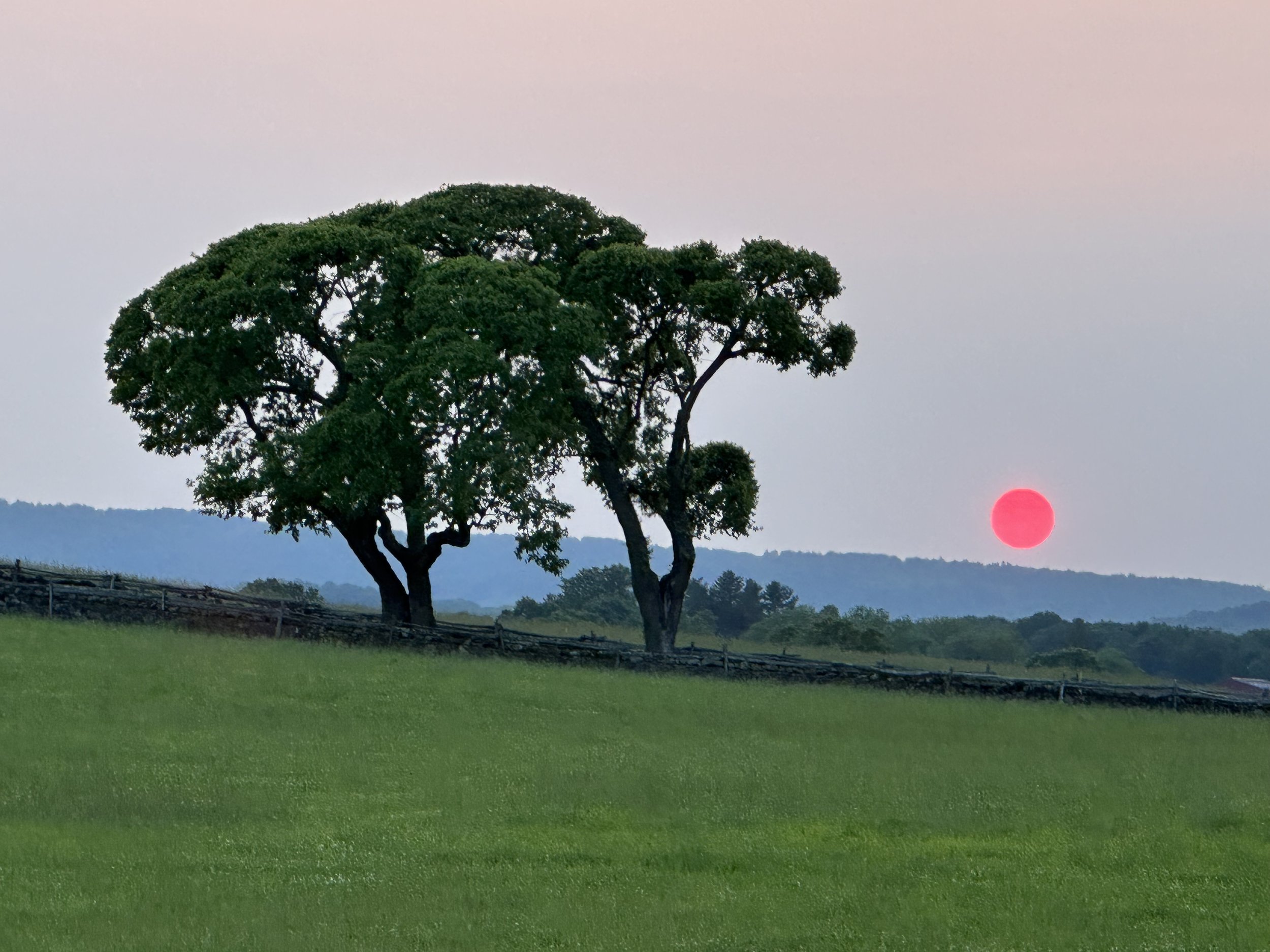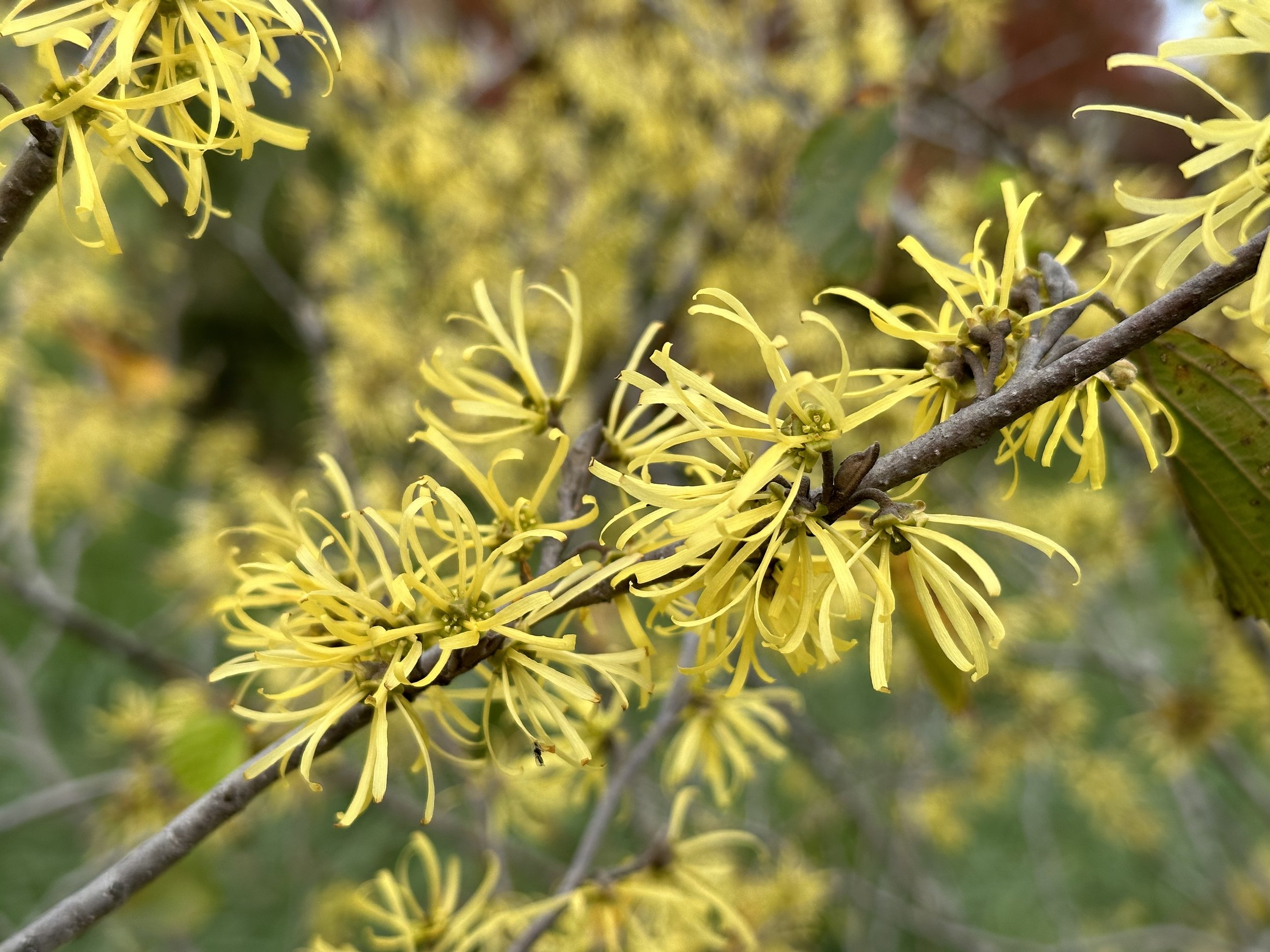
Woody Plants
Woody Plants at the Oak Spring Garden Foundation
Trees are an integral part of the landscape at the Oak Spring Garden Foundation (OSGF). On both Little Oak Spring and on Rokeby - to the west and east of Route 623 respectively - trees are important in the broader natural landscape as well as in the more intensively managed areas around key buildings. So far, the OSGF Tree Inventory and Management Plan (TIMP)has recorded 1,125 trees across the landscape, excluding the densely wooded areas. More than 110 species of woody plant species have been recorded and the TIMP database includes information on the location, size, age, and condition of each tree, along with an initial assessment of structure, health, and vigor. The further development of this inventory will allow us to monitor and maintain a healthy population of trees across the whole estate. For example, one result of this work has been the upgrading lightning protection in several of our most important tree specimens.
Native Trees Shrubs
Initial surveys in 2017 and 2018 established that there were 45 native tree species on Little Oak Spring and 39 native tree species on Rokeby. Since then, further records have been added, bringing the combined list of native trees to over 50 across both sites. This total reflects the rich diversity of native trees in eastern North America, and a number of tree species greater than the number of species in Yosemite and Yellowstone National Parks combined.
Only small pockets persist of the original oak-hickory forest on both Little Oak Spring and Rokeby. In general, however, these forest remnants have been highly modified by human activity in the past, including the harvesting of timber, the grazing of cattle and the loss or decline of some species due to disease (e.g., American chestnut, Castanea dentata). Today these remnants are also under pressure from non-native species, some of which are invasive, and overgrazing by white-tailed deer.
Among the open-grown trees on Little Oak Spring and Rokeby, black locust (Robinia pseudoacacia), white oak (Quercus alba) and hackberry (Celtis occidentalis) are among the most ubiquitous species. Black walnut (Juglans nigra), northern red oak (Quercus rubra), persimmon (Diospyros virginiana), red maple (Acer rubrum) are also common. Also present, but in lesser amounts, are a variety of other species including sugar maple (Acer saccharum), bitternut hickory (Carya cordiformis), pignut hickory (Carya glabra), mockernut hickory (Carya tomentosa), white pine (Pinus virginiana), black cherry (Prunus serotina), pin oak (Quercus palustris), willow oak (Quercus phellos) and slippery elm (Ulmus rubra). There are also a few large open-grown American sycamores (Platanus occidentalis).
White ash (Fraxinus americana) was once common on the landscape, but most of these trees have succumbed, or are succumbing, to emerald ash borer. There is, however, extensive regeneration of ash seedlings, which we are encouraging, and seeking to protect with hope that some will survive. Common trees regenerating in the meadows include black locust (Robinia pseudoacacia) and persimmon (Diospyros virginiana) both of which are not favored by white-tailed deer. There is also some regeneration in certain locations, including along the runway on Rokeby, by black willow (Salix nigra) and eastern red cedar (Juniperus virginiana).
Trees and Shrubs around the Main Mellon Residence
Woody plants around the Main Residence are integral to the setting of the home and associated buildings in the landscape. Along with the hard landscape in the walled garden they also provide key elements of its structure. Also especially important are the 60 carefully pruned crabapples (Malus ‘Mary Potter’) that comprise the arbor, the signature horticultural feature of the Oak Spring estate.
On the main approach to the house the dominant feature is newly planted shingle oak (Quercus imbricaria) but there is also yellow wood (Cladrastis kentukea), catalpa (Catalpa bignoniodes), and Turkish hazel (Corylus colurna). There is a large, espaliered Asian pear (Pyrus pyrifolia) against the west wall of the Main Residence.
Inside the walled garden, on the brick terrace outside the door to the brick hallway and on the upper flagstone terrace, the most prominent woody plants are a fragrant viburnum (Viburnum farreri), a flowering dogwood (Cornus florida ‘Cherokee Princess’), a blackhaw viburnum (Viburnum prunifolium), an American holly (Ilex opaca), a hardy orange (Poncirus trifoliata), winter hazels (Corylopsis sp.) and several boxwoods (Buxus microphylla ‘Compacta’). There is also a sugar pear (Pyrus communis ‘Seckel’) with a second on the middle terrace. Also on the middle terrace are four crab apples (Malus sargentii ‘Firebird’), placed at each corner of the square beds and a Nellie Stevens Holly (Ilex ‘Nellie Stevens’) pruned into three horizontal segments. The size of this specimen and the way it has been pruned matches the treatment of the hollies in the Jacqueline Kennedy Garden (East Garden) of the White House, which were planted about the same time. On the lower terrace of the walled garden there are apples espaliered against the north wall of the garden, a further hardy orange and a damson plum (Prunus domestica subsp. institia).
The arbor, composed of 60 meticulously pruned crabapples was planted around 1963 shortly after the construction of the formal glass house. These are some of most precious plants on the entire Oak Spring estate. Replacements from the same genetic stock are being grown offsite so that they will be available when needed. In addition to the crab apples (Malus ‘Mary Potter’) the arbor is flanked by two external lines of boxwood.
In June 2022, a devastating storm ripped through the Oak Spring landscape and the surrounding area with measured wind gusts up to 60 mph, and likely (unmeasured) localized gusts of up to 80 mph. A large number of trees were lost across the estate. The losses included several of the Foundation’s most significant trees, including the Darlington oak (Quercus hemisphaerica) in the walled garden and the European beech tree (Fagus sylvatica) outside the entrance to the Main Residence. The loss of these trees created an opportunity for the Foundation to research Mrs. Mellon’s original design intentions with the replacement of these trees. Careful analysis led to the decision to install a shingle oak (Quercus imbricaria) in place of the beech tree outside the entrance to the Main Residence. A simple replacement with a new European beech was rejected due to the threat of beech leaf disease. Similarly, examination of historic plans and photographs led to a decision to restore the separation between the croquet lawn and main garden terraces originally implemented by Mrs. Mellon as a line of Darlington oaks, the last of which fell in the 2022 storm. Using a species Mrs. Mellon employed elsewhere it was decided to restore the separation with a species line of five American hornbeams (Carpinus caroliniana) that will not grow so large.
Rokeby Arboretum
Trees around the Nora Mellon House on Rokeby include a mix of natives, such as sugar maple (Acer saccharum), red maple (Acer rubrum) and black locust (Robinia pseudoacacia), together with several non- native species, including the European horse chestnut (Aesculus hippocastanum), Turkish hazel (Corylus colurna), Norway spruce (Picea abies), Norway maple (Acer platanoides), larch (Larix sp.) and a flowering cherry (Prunus sp.). Some of these trees, including the horse chestnut, were lost in the June 2022 storm, but since then new plantings of non-native trees and shrubs around the Nora Mellon house have been strengthened to include a range of interesting species. These include natives such as franklinia (Franklinia alatamaha) and non-natives, such as ginkgo (Ginkgo biloba), dawn redwood (Metasequoia glyptostroboides), Japanese pagoda tree (Styphnolobium japonicum), Persian ironwood (Parrotia persica) and paperbark maple (Acer griseum). These plantings are some of the first that are aimed towards the development of an arboretum in the core Rokeby landscape. The arboretum will highlight the diverse trees and shrubs of eastern north America, and their close relatives in eastern Asia. The arboretum will also include species of conservation concern and species that are helpful for research in plant evolutionary biology.
An early focus of new plantings for the arboretum in the area to the east of the Nora Mellon House has been the development of a collection of oaks, including chestnut oak (Quercus montana), shingle oak (Quercus imbricaria), cherrybark oak (Quercus pagoda), Shumard oak (Quercus shumardii) and bur oak (Quercus macrocarpa). A collection of trees with edible fruits or seeds has also been planted around the School House, including paw paw (Asimina triloba) and pecan (Carya illinoinensis). On Mill Reef Road two scarlet oaks (Quercus coccinea), planted in memory of our late friend Tremaine Cooper, together with six bottlebrush buckeyes (Aesculus parviflora) and two dogwoods (Cornus florida) mark the entrance to the developing arboretum.
White Oak Project
White oak (Quercus alba) is one of the most common and important native trees of the Oak Spring landscape. It is a very beneficial tree for wildlife, but natural regeneration is poor, in part because of overgrazing by deer. The White Oak Improvement Project was initiated in 2023 in a newly established fenced area on Rokeby. The project is led by the University of Kentucky Department of Forestry and Natural Resources in collaboration with the US Forest Service Southern Research Station and State of Kentucky Division of Forestry. The project is funded in part by the Bourbon Industry, which uses white oak timber to make the barrels in which bourbon is aged.
A total of 792 white oak saplings were planted in spring 2023, all of which are replicates of the seed collected from 34 ‘mother’ Virginia white oak trees. After planting, the white oak saplings were carefully measured over two days with assistance from Dr. Carrie Pike of the US Forest Service. Seedling growth will be regularly monitored in future years to assess which seedlings grow well and may be valuable for timber and for landscape restoration. These replicates are surrounded by a border planting of mixed native trees from Virginia and Maryland. Oak Spring is one of a network of sites where similar trials are taking place based on acorns collected from across the native range of white oak.
Fruit Trees
Historic photograph and documents show that orchards were part of the Oak Spring landscape before the era of Mellon stewardship. Fruit production at Oak Spring continues and apple trees alone comprise almost a quarter of all the free-standing trees in the Little Oak Spring landscape. They are especially concentrated around the Main Residence and the Library, as well as near the Loughborough production greenhouse. Compared to apples, other fruit trees are few, but include pears and peaches, as well as plum, apricot and cherries, which are only very sparsely represented.
Fruit trees were especially admired by Mrs. Mellon and our Arboriculture, Conservation and Landscape Team continue to prune them in the distinctive Mellon style. Such pruning does not maximize fruit production but adds a special Mellon character to the landscape that we are keen to preserve. Fruit trees are also pruned into espaliers and cordons in the walled garden. The apple trees on Little Oak Spring still produce plenty of fruit, which we use for guests and convert each year into apple butter.
Many of the apple trees growing on the property today date from the Mellon era, but many new apple trees have been planted over the last few years and some of the trees that have been lost over the years have been replaced. A new fruit orchard has also been established on Rokeby as part of the Biocultural Conservation Farm.
Gallery
See below for the beginning of a selected photographic inventory of the woody plants growing on the Oak Spring estate. Please check back as this photographic inventory is gradually extended.






